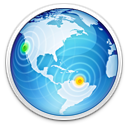
If you’re using an external DNS name server and you entered its IP address in the Gateway Setup Assistant, you don’t need to do anything else. If you’re setting up your own DNS server, you must do the following.
Register your domain name
Domain name registration is managed by IANA. IANA registration makes sure that domain names are unique across the Internet. (For more information, go to http://www.iana.org.)
If you don’t register your domain name, your network can’t communicate over the Internet.
After you register a domain name, you can create subdomains as long as you set up a DNS server on your network to track the subdomain names and IP addresses.
For example, if you register the domain name example.com, you could create subdomains such as host1.example.com, mail.example.com, or www.example.com. A server in a subdomain could be named primary.www.example.com or backup.www.example.com.
The DNS server for example.com tracks information for its subdomains, such as host (computer) names, static IP addresses, aliases, and mail exchangers.
If your ISP handles your DNS service, you must inform them of changes you make to your domain name, including added subdomains.
The range of IP addresses used with a domain must be clearly defined before setup. These addresses are used exclusively for one specific domain, never by another domain or subdomain. Coordinate the range of addresses with your network administrator or ISP.
Learn and plan
If you’re new to DNS, learn and understand DNS concepts, tools, and features of OS X Server and BIND. See Find more DNS information.
When you’re ready, plan your DNS service. Consider the following questions:
Do you need a local DNS server? Does your ISP provide DNS service? Can you use multicast DNS names instead?
How many servers do you need? How many additional servers do you need for backup DNS purposes? For example, should you designate a second or third computer for DNS service backup?
What is your security strategy to deal with unauthorized use?
How often should you schedule periodic inspections or tests of DNS records to verify data integrity?
How many services or devices (such as intranet websites or network printers) need a name?
There are two ways to configure DNS service on a Mac server:
Use the Server app. This is the recommended method.
Edit the BIND configuration file. BIND is the set of programs used by OS X Server that implements DNS. One of those programs is the name daemon, or named. To set up and configure BIND, you must change the configuration file and the zone file. The configuration file is /etc/named.conf.
The zone file name is based on the name of the zone. For example, the zone file example.com is /var/named/example.com.zone.
If you edit named.conf to configure BIND, don’t change the inet settings of the controls statement. Otherwise, the Server app can’t retrieve status information for DNS.
The inet settings should look like this:
controls {inet 127.0.0.1 port 54 allow {any;}keys { "rndc-key"; };};Important: In OS X Server v10.6 or later, the configuration and zone files used by the Server app are different. If you edit named.conf and zone files manually in Terminal, the information is used by DNS. However, the information doesn’t appear in the DNS pane of the Server app. Also, changes made in the Server app aren’t made to named.conf.